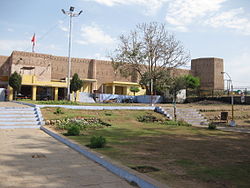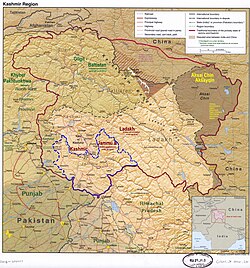Jammu district | |
|---|---|
 Bahu Fort, Jammu, India | |
 Interactive map of Jammu district | |
 Jammu district is in the Jammu division (shown with neon blue boundary) of Indian-administered Jammu and Kashmir (shaded in tan in the disputed Kashmir region [1] | |
| Coordinates(Jammu): 32°44′N74°52′E / 32.73°N 74.87°E | |
| Administering country | India |
| Union territory | Jammu and Kashmir |
| Division | Jammu Division |
| Headquarters | Jammu |
| Government | |
| • District Magistrate | Sachin Kumar Vaishya(IAS) |
| • Lok Sabha constituencies | Jammu (Lok Sabha constituency) |
| • Vidhan Sabha constituencies | 11 |
| Area | |
• Total | 2,342 km2 (904 sq mi) |
| • Urban | 252.13 km2 (97.35 sq mi) |
| • Rural | 2,089.87 km2 (806.90 sq mi) |
| Population (2011) [3] | |
• Total | 1,529,958 |
| • Density | 653.3/km2 (1,692/sq mi) |
| • Urban | 765,013 |
| • Rural | 764,945 |
| Demographics | |
| • Literacy | 83.45% |
| • Sex ratio | 880 |
| Time zone | UTC+05:30 (IST) |
| Vehicle registration | JK-02 |
| Website | http://jammu.nic.in/ |
Jammudistrict is an administrative district of the Jammu division of Indian-administered Jammu and Kashmir in the disputed Kashmir region. [1] It is the most populous district in the Jammu division. [4]